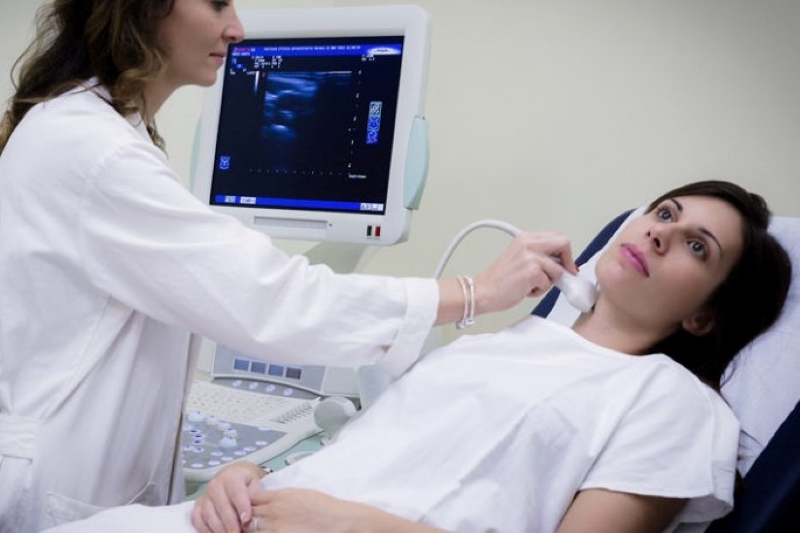
What is echocolordoppler?
Echocolordoppler is a non-invasive method that, by visualising the major blood vessels (arteries, large abdominal vessels, supra-aortic trunks, venous system), allows the blood flow to be studied
The echocolordoppler provides colour images (red and blue) of venous and arterial flow, highlighting even the smallest lesions in the vessel walls and allowing their precise evaluation.
What is echocolordoppler used for?
Echocolordoppler can be very useful for studying and monitoring major vascular diseases (arterial and venous stenosis, aneurysms, thrombosis and venous insufficiency) or for detecting atherosclerotic lesions, the plaques that obstruct blood flow and can cause venous thrombi.
The test is used to reveal any aneurysms or stenosis and occlusions in the large abdominal blood vessels, pathologies that often develop without providing any particular symptoms.
If the area to be subjected to an echocolordoppler is the abdomen, the patient must be fasting.
This is because the abdominal vessels are located in the vicinity of the intestine, which, if not empty and free of air, can prevent a proper view on the ultrasound machine screen.
Who can have an echocolordoppler examination?
Anyone can undergo the test.
Is the echocolordoppler painful or dangerous?
The test is not painful or bothersome and has no contraindications.
How is the echocolordoppler performed?
The patient lies on the couch and a gel is applied to the part of the body to be examined.
The doctor then places a probe on it to obtain the images – which appear on the screen of the ultrasound machine – that will be used to make the diagnosis.
The echocolordoppler test takes about twenty minutes.
Read Also
Emergency Live Even More…Live: Download The New Free App Of Your Newspaper For IOS And Android
What Is Echocolordoppler Of The Supra-Aortic Trunks (Carotids)?
What Is The Loop Recorder? Discovering Home Telemetry
Cardiac Holter, The Characteristics Of The 24-Hour Electrocardiogram
Peripheral Arteriopathy: Symptoms And Diagnosis
Endocavitary Electrophysiological Study: What Does This Examination Consist Of?
Cardiac Catheterisation, What Is This Examination?
Echo Doppler: What It Is And What It Is For
Transesophageal Echocardiogram: What Does It Consist Of?
Venous Thrombosis: From Symptoms To New Drugs
Heart Murmur: What Is It And What Are The Symptoms?
Cardiopulmonary Resuscitation Manoeuvres: Management Of The LUCAS Chest Compressor
Supraventricular Tachycardia: Definition, Diagnosis, Treatment, And Prognosis
Identifying Tachycardias: What It Is, What It Causes And How To Intervene On A Tachycardia
Tachycardia: Is There A Risk Of Arrhythmia? What Differences Exist Between The Two?
Do You Have Episodes Of Sudden Tachycardia? You May Suffer From Wolff-Parkinson-White Syndrome (WPW)
Transient Tachypnoea Of The Newborn: Overview Of Neonatal Wet Lung Syndrome
Paediatric Toxicological Emergencies: Medical Intervention In Cases Of Paediatric Poisoning
Valvulopathies: Examining Heart Valve Problems
What Is The Difference Between Pacemaker And Subcutaneous Defibrillator?
Heart Disease: What Is Cardiomyopathy?
Inflammations Of The Heart: Myocarditis, Infective Endocarditis And Pericarditis
Heart Murmurs: What It Is And When To Be Concerned
Broken Heart Syndrome Is On The Rise: We Know Takotsubo Cardiomyopathy
Cardiomyopathies: What They Are And What Are The Treatments
Alcoholic And Arrhythmogenic Right Ventricular Cardiomyopathy
Difference Between Spontaneous, Electrical And Pharmacological Cardioversion
What Is Takotsubo Cardiomyopathy (Broken Heart Syndrome)?
Dilated Cardiomyopathy: What It Is, What Causes It And How It Is Treated
Heart Pacemaker: How Does It Work?
Basic Airway Assessment: An Overview
Assessment Of Abdominal Trauma: Inspection, Auscultation And Palpation Of The Patient
Pain Assessment: Which Parameters And Scales To Use When Rescuing And Treating A Patient
Airway Management After A Road Accident: An Overview
Tracheal Intubation: When, How And Why To Create An Artificial Airway For The Patient
What Is Traumatic Brain Injury (TBI)?
EMS: Pediatric SVT (Supraventricular Tachycardia) Vs Sinus Tachycardia
Acute Abdomen: Meaning, History, Diagnosis And Treatment
Poison Mushroom Poisoning: What To Do? How Does Poisoning Manifest Itself?
Chest Trauma: Clinical Aspects, Therapy, Airway And Ventilatory Assistance
The Quick And Dirty Guide To Pediatric Assessment


